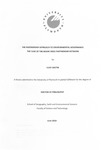THE PARTNERSHIP APPROACH TO ENVIRONMENTAL GOVERNANCE: THE CASE OF THE MOOR TREES PARTNERSHIP NETWORK
| dc.contributor.author | Bastin, Clive | |
| dc.contributor.other | School of Geography, Earth and Environmental Sciences | en_US |
| dc.date.accessioned | 2013-02-12T09:59:10Z | |
| dc.date.available | 2013-02-12T09:59:10Z | |
| dc.date.issued | 2010 | |
| dc.date.issued | 2010 | |
| dc.identifier | Not available | en_US |
| dc.identifier.uri | http://hdl.handle.net/10026.1/1309 | |
| dc.description | File taken down by request on 11.03.14 by NC TIS | |
| dc.description | This item has a duplicate that has been withdrawn from the Research Theses Collection: http://pearl.plymouth.ac.uk/handle/10026.1/1755 | |
| dc.description | Access to the full-text thesis is no longer available at the author's request, due to 3rd party copyright restrictions. Access removed on 29.11.2016 by CS (TIS). | |
| dc.description | Merged with duplicate record (10026.1/1755) on 03.01.2017 by CS (TIS) | |
| dc.description.abstract |
Academic discussion of policy-making and governing indicates a significant shift in the model of governance away from top-down state control to the bottom-up approach of engaging non-state actors (Goodwin and Painter, 1996; Jessop, 1998; Stoker, 1993, 1998). Central to governance theory are new forms of policy organisation, in effect, a shift from state monopoly of decision-making towards partnering with non-state (and, therefore, non-elected) actors for the formulation and delivery of sustainability objectives. It is argued that these partnerships are a key aspect of governance, which, in turn has become one of the main themes in environmental politics (Imrie and Raco, 1999; MacKinnon, 2000; Goodwin and Painter, 1996; Stoker, 1998). In part, the growing prominence of environmental partnership-working is a recognition that sustainability cannot be achieved through top-down government, but requires the active involvement of a broad range of non-state stakeholder groups spanning all sections of society to ensure that sustainability strategies are context-oriented and meet the needs of local populations. This study refers to these objectives as 'environmental plans, policies and programmes' (EPPP). I suggest that contemporary academic debate is lacking in conceptual and empirical focus on partnership-working as a delivery mechanism for environmental governance. This thesis aims to address this gap by; (i) assessing the implications of the state's devolution of responsibility for the delivery of EPPP to the community level; (ii) investigating the democratic legitimacy of these non-state actors; (iii) appraising the financial and operational accountability of state non-state partnerships; and (iv) furthering the understanding of the practical issues that environmental partnership-working must address in order to become an effective delivery vehicle for environmental policy objectives. In meeting these objectives, this thesis has conceptualised the formulation and delivery of EPPP via the Policy Implementation Continuum. The continuum is stratified into four sectors: state', 'QUANGO', 'third', and 'private'. I argue that the success of these partnerships revolves on actors from across all four layers meeting the three requirements of; (i) accepting responsibility, (ii) acquiring legitimacy, and (iii) providing accountability. To this end, I argue that these three constructs are critical components of the Effective Partnership-working model. I argue that, without achieving all three, partnerships cannot work effectively and that the implementation gap between policy and practice will remain. | en_US |
| dc.language.iso | en | en_US |
| dc.publisher | University of Plymouth | en_US |
| dc.title | THE PARTNERSHIP APPROACH TO ENVIRONMENTAL GOVERNANCE: THE CASE OF THE MOOR TREES PARTNERSHIP NETWORK | en_US |
| dc.type | Thesis | |
| plymouth.version | Full version | en_US |
| dc.identifier.doi | http://dx.doi.org/10.24382/3450 |
Files in this item
This item appears in the following Collection(s)
-
01 Research Theses Main Collection
Research Theses Main


